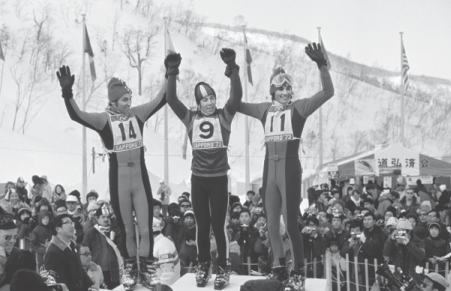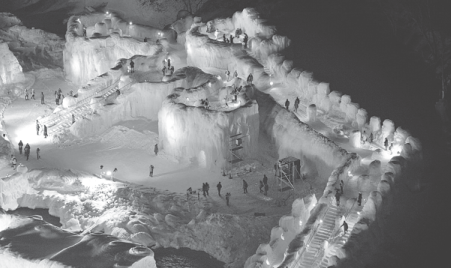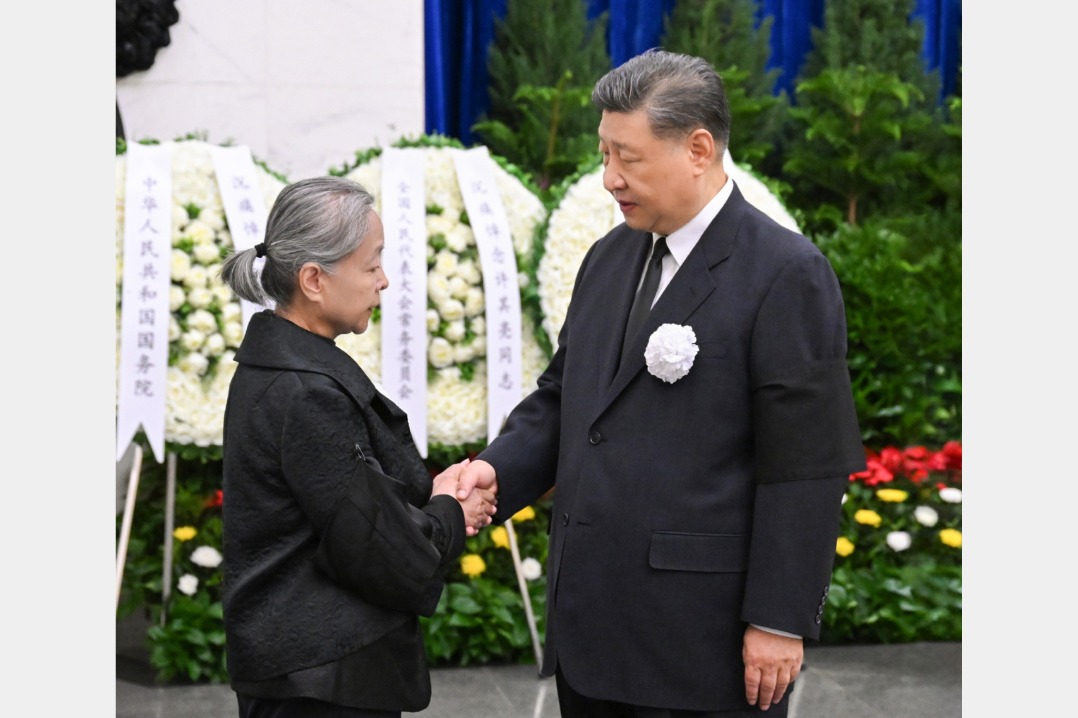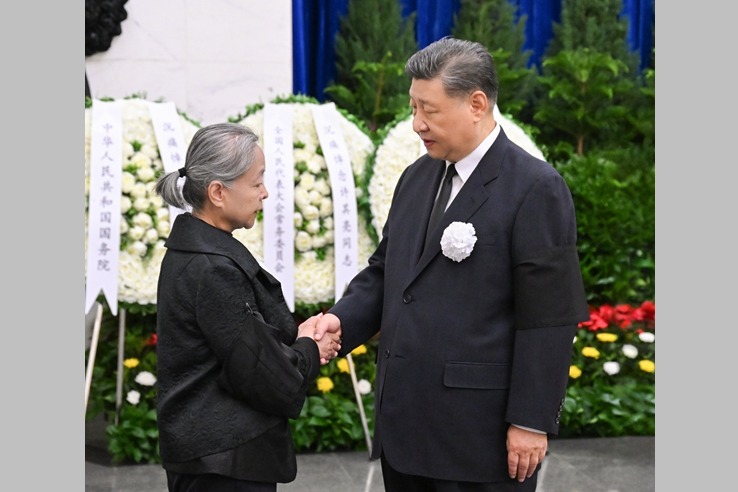Japan snow sports industry in focus
Resorts in China looking to snatch their neighbor's crown as it becomes an emerging destination for skiers, Wang Xu reports

With winter on its way in Japan, Jun Aihara is going through a hard time shadowed by the COVID-19 pandemic toward qualification for Beijing, where the 2022 Winter Paralympics will take place on March 4-13.
He lost his left arm in a motorbike accident when he was 26. Aihara, now in his 30s, regards attending the Paralympics as a highlight of his life.
"I am not sure if I can still make it this time because I am running out of time. But what I am sure is that I will never give up, I will just keep trying," Aihara said. He aims to compete in the class SB-UL para-snowboarding, a category for athletes with a physical upper limb impairment that affects balance.
Working as a coach at a snowboarding school in Kagura, a ski resort located in Yuzawa, Niigata prefecture, Aihara said he grew up as winter sport was gaining popularity in Japan.
"The accident happened when I was on a trip to ski with my friends and for years I wished I had not gone on that trip. But then, I started to realize that the sport is just so much a part of my life that I have always known. Dropping it is like dropping the whole dynamic of myself."
Born in the late 1980s, Aihara learned skiing and snowboarding at a time when Japan was experiencing an economic boom that vastly changed the country's infrastructure and recreation, including skiing grounds.
When Japan National Railway started to relax its restrictions on passengers carrying ski equipment from the 1960s, a 24-hour round trip to skiing grounds from big cities first became possible. And the number of skiing enthusiasts grew rapidly, peaking in the early 1990s.
As a result, Japan built more than 500 ski resorts with 200 of them with five or more lifts, becoming the country with the second-largest number of such facilities behind the United States.
Throughout the Japanese islands, from the northern part of Hokkaido to the southern island of Kyushu, almost the entire population is only a few hours away from a ski area.
The number of active skiers also broke a record in the 1990s. Data from Japan's Ministry of Education, Culture, Sports, Science and Technology showed that more than 21.2 million people enjoyed winter sports at its peak in 1992-93.
In a research paper in 2020, Ding Hongwei and Wang Yufei argued that the development of Japan's ice and snow industry went through four stages: the popularity of ice and snow sports driven by professional winter sports events; the complementary stimulus of ice and snow sports and leisure and tourism; the gradual shrinking of the industry scale after the bubble economy burst; and the efficient attraction of overseas tourists in the context of an aging society.
"It has gone through a process of initiation, boom, recession and recovery," Ding and Wang wrote in their paper. They added that the Japanese government introduced relevant laws, regulations and policy measures in each period.
"The two most important measures (of the Japanese government) were to guide the deep integration between the ice and snow industry and tourist industry, and to formulate strict ecological and environmental protection standards, which ensured the sound development of the ice and snow industry," they said.
Yosuke Tsuji, a sports marketing professor at Rikkyo University in Tokyo said sports tourism became better known to the Japanese public after a Liaison Conference for the Promotion of Sports Tourism was held in 2010.
According to Tsuji, after the conference, the Basic Policy to Promote Sports Tourism was formulated and, to implement policy regarding sports tourism, the Japan Sport Tourism Alliance was established in 2012.
"At the same time, the Japanese government enacted the Basic Act on Sport, which specifically addressed the role of sport in reviving regional communities, societies and economies. Furthermore, to realize the basic ideas in the act, the Japanese government formulated the Sport Basic Plan in 2012 and the Second Sport Basic Plan in 2016, in which sport was designated as one of the key economic drivers to revitalize Japan," Tsuji said.
'Successful policy'
"Japan's policy guide to develop the winter sports industry has been rather successful," said Yu Qiang, a researcher of Japan studies at the University of International Relations in Beijing.
"Japan's Sapporo and Nagano were the host cities of the Winter Olympic Games in 1972 and 1998," said Yu. He added that both events contributed to a tremendous boom of the industry in the domestic market.
"Winter sports became fashionable in Japan and skiing was the most popular sport among young people at that time," Yu said.
According to government data, sports tourism-related consumption in Japan grew from 220.4 billion yen ($2.1 billion) in 2015 to around 289.2 billion yen in March 2019. In the winter sports sector, the number of foreign travelers nearly tripled between 2013-17.
A 2018 survey by the Japan Sports Agency showed that winter sports are some of the most sought-after activities along with hiking, trekking, cycling and walking in Japan. They are considered to be one of the top choices for foreign travelers during their visits to Japan.
Yu said because Japan receives some of the highest snowfall in the world and its mountains are typically much lower than those in Europe and North America, the country can offer some of the world's best conditions for powder and tree skiing.
"In winter time, cold air moves from west to east from the Asian continent, bringing seawater with it. That water then condenses as it is lifted above the mountains along the north coast of Japan, resulting in heavy snowfall and excellent powder," Yu said. He added: "There is a word known as 'Japow' on social networking services, which refers to the powder snow of Japan."
Meanwhile, Yu said the lower altitude means a warmer average temperature during winter, so that trees on mountain slope in Japan are mostly deciduous rather than coniferous and they grow further apart, which makes it easy for tree skiing.
The unique characteristics of winter sports in Japan, and an overall revitalizing effort to transform ski areas into big resorts where skiing is only one of many activities to choose from, had attracted many foreign skiers to the country. It was an effective compensation for losing participation due to the demographic reality of an aging Japanese population.
From abroad
According to the 2021 International Report on Snow& Mountain Tourism, before the 2000s, nearly no foreign visitors came to Japan to ski. Today, the country attracts more and more skiers from abroad.
"It is now common to see skiers from Australia and East Asia (in Japan). Very recently, China became one of the most promising markets for skiing in Japan. Chinese skiers going to Japan currently represent the largest international skier flow in the Asia-Pacific region. Focus has also now turned to attracting European and US skiers," the annual report said.
The report also said that after a succession of seasons with decreasing attendance in recent years, the situation seemed to have stabilized in Japan. But the COVID-19 pandemic made the 2019-20 season end with visitation down 21.7 percent.
Although Japan was one of the world's largest ski nations to carry on the sport through the pandemic, strict border controls have kept foreign tourists at bay.
The absence of foreign enthusiasts has bankrupted resorts in some of Japan's most popular snow destinations, a Nikkei report said. It added that the surviving resorts needed to prepare for a long winter of heavy price competition.
"The number of visitors is very low," a representative of a ski resort in the Niseko region of Hokkaido was quoted by Nikkei as saying. He added that the resort usually welcomes 80-90 percent of its guests from abroad, mainly from Hong Kong and Southeast Asian countries such as Singapore, Thailand and Indonesia. But with core customers gone, the resort has been trying to cater to Japanese guests by discounting tickets and altering restaurant menus-offering less expensive dishes in smaller portions.
With COVID-19 concerns high on people's minds, the Japan Funicular Transport Association, an organization made up of ski resort operators and others, set out new guidelines last year. They urged each of its member businesses to limit the number of gondola and ropeway passengers, setting spaces between passengers and carrying out disinfections at set times.
Although most of the Japanese population are living under a state of emergency, there is no report so far of super-spreader events in ski areas like the one in Ischgl, Austria, or the Sun Valley in Idaho state, the United States.
'Good reference'
With the 2022 Winter Olympics and Paralympics around the corner, Ding and Wang said in their paper that: "The development course and relevant practices of Japan's ice and snow industry provide a good reference for the development of China's ice and snow industry."
As one of most obvious emerging destinations of winter sports, China catching up with Japan is a factor that increases the weight of Asia in the international spread of skier visits, the 2021 International Report on Snow& Mountain Tourism said.
The report said more than half of all indoor snow centers built in the past decade were in China. With the boost of winter sports triggered by the 2022 Winter Olympics, ski areas are now blossoming in nearly all Chinese provinces. It added that in 2018, 28 new ski areas opened in China, bringing the total to 770 ski areas. However, most of them are not fully equipped and are rather ski fields for beginners.
"China will soon rank among the big players of the industry, even if this has been slowed down by the pandemic. During the 2019-20 season, Chinese ski areas were the first to have to close down, but they were also among the first to reopen ...thanks to the strict control over the virus," the report said.
Commenting on the report, Yu in Beijing, urged businesses in China to be cautious of overheating the winter sports market. "The popularity of a sport can be driven by professional events like the Olympics at the beginning stage," Yu said. "But it is not 100 percent guaranteed."
According to Yu's study, the Pyeongchang 2018 Winter Olympic Games was an example that failed to increase the popularity of skiing in South Korea.
"South Korea has 2.5 million skiers for a population of more than 48 million inhabitants. Statistically speaking, the country's participation rate of about 5 percent left a big space for the potential market, which is partially untapped and where demand could be further developed," Yu said.
"However, the 2018 Winter Games failed to increase skiing's popularity in South Korea because data showed that people's visitation to ski resorts in the 2017-18 winter season was 10 percent down compared to the former one and 20 percent below a five-year average."
"In 2018-19, there was a stop to the declining numbers with a stabilization around the former year level. But with the pandemic, the winter of 2019-20 saw again a decrease in visitation of 14.3 percent over former season," Yu said.




Today's Top News
- China unveils first deep-sea testing site
- Green algorithms leading sustainable revolution
- Tech narratives equally vital in AI progress
- China approves some rare earth export applications
- Sino-US talks expected to help build up consensus
- National Guard arrives in Los Angeles amid immigration protests






























